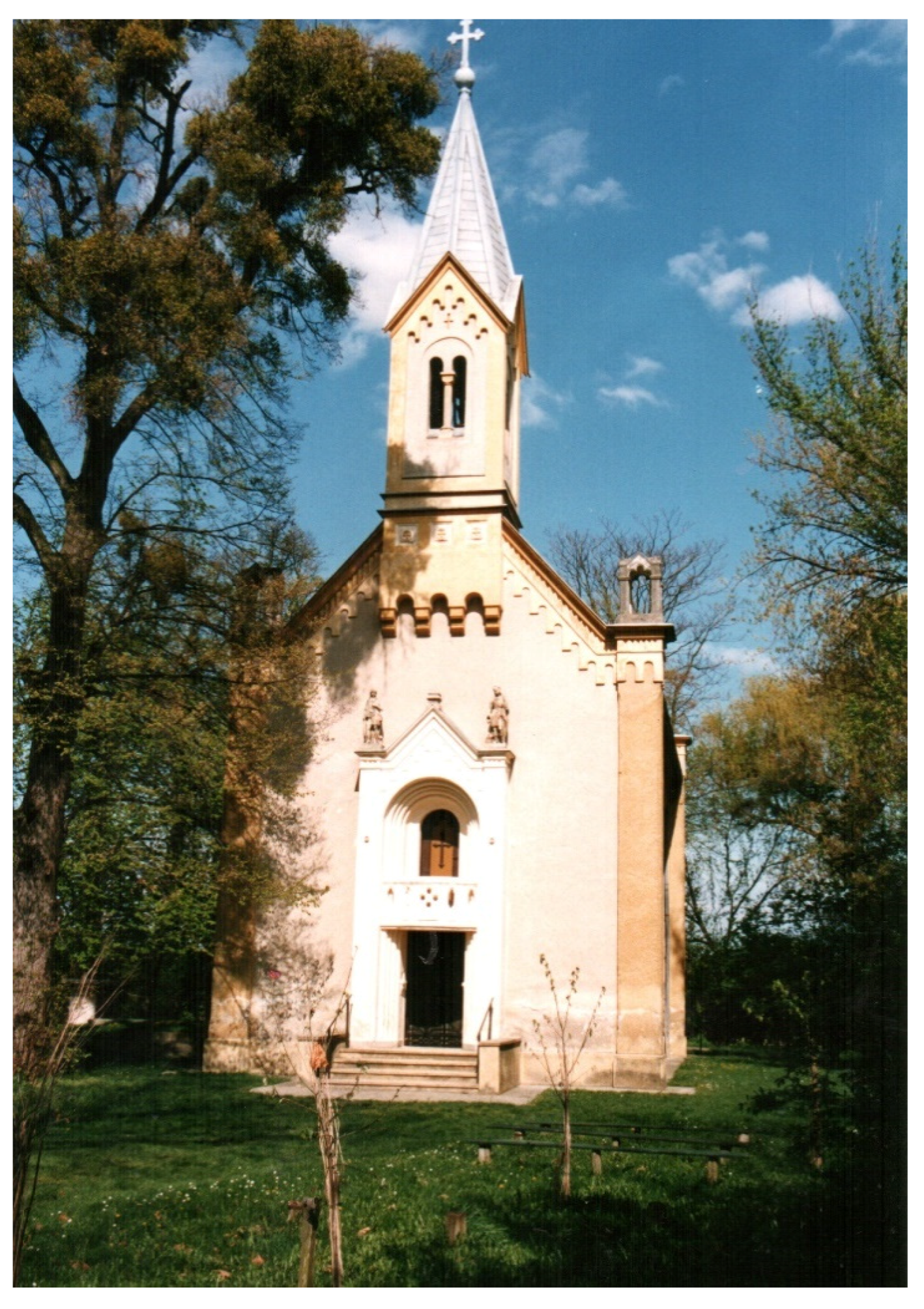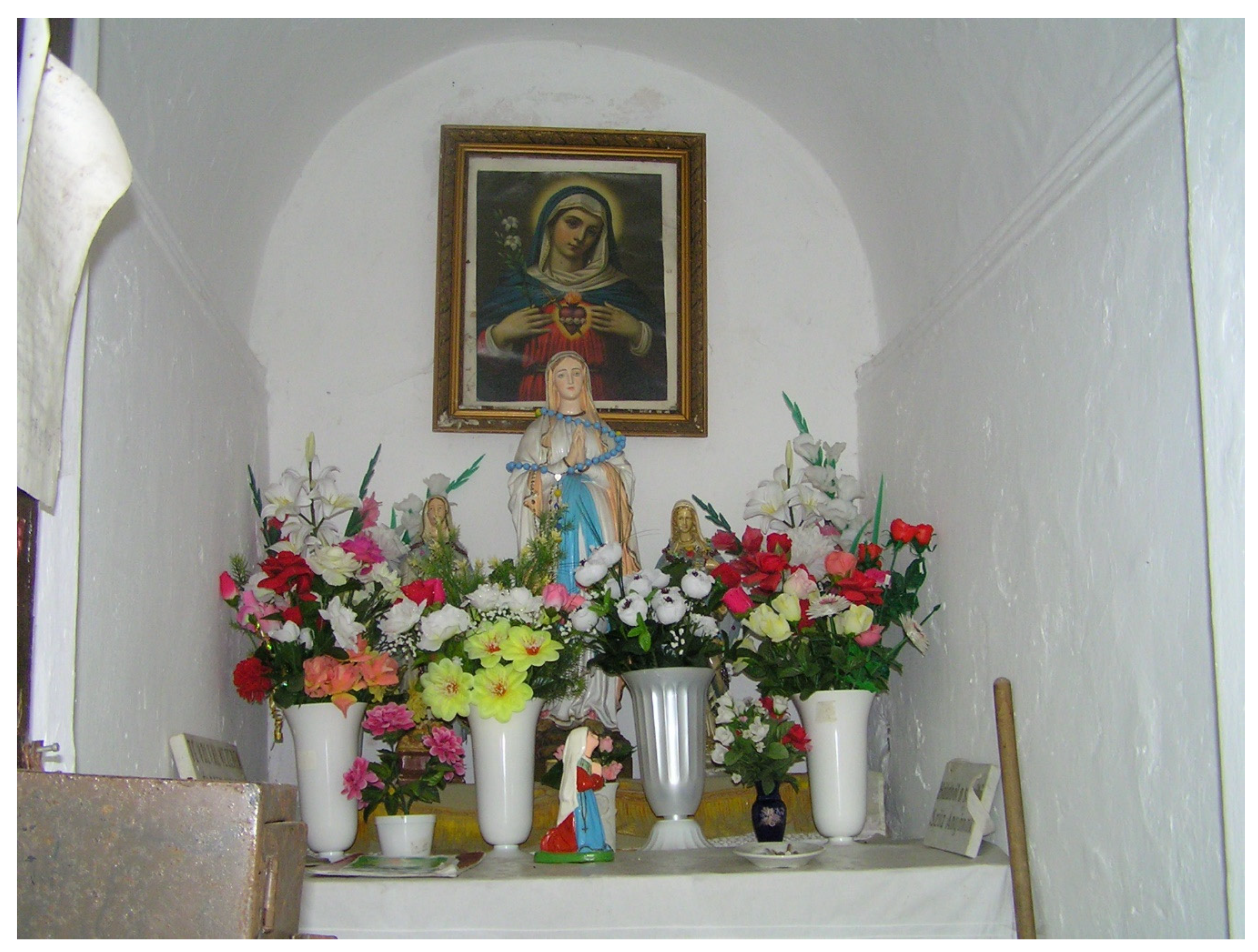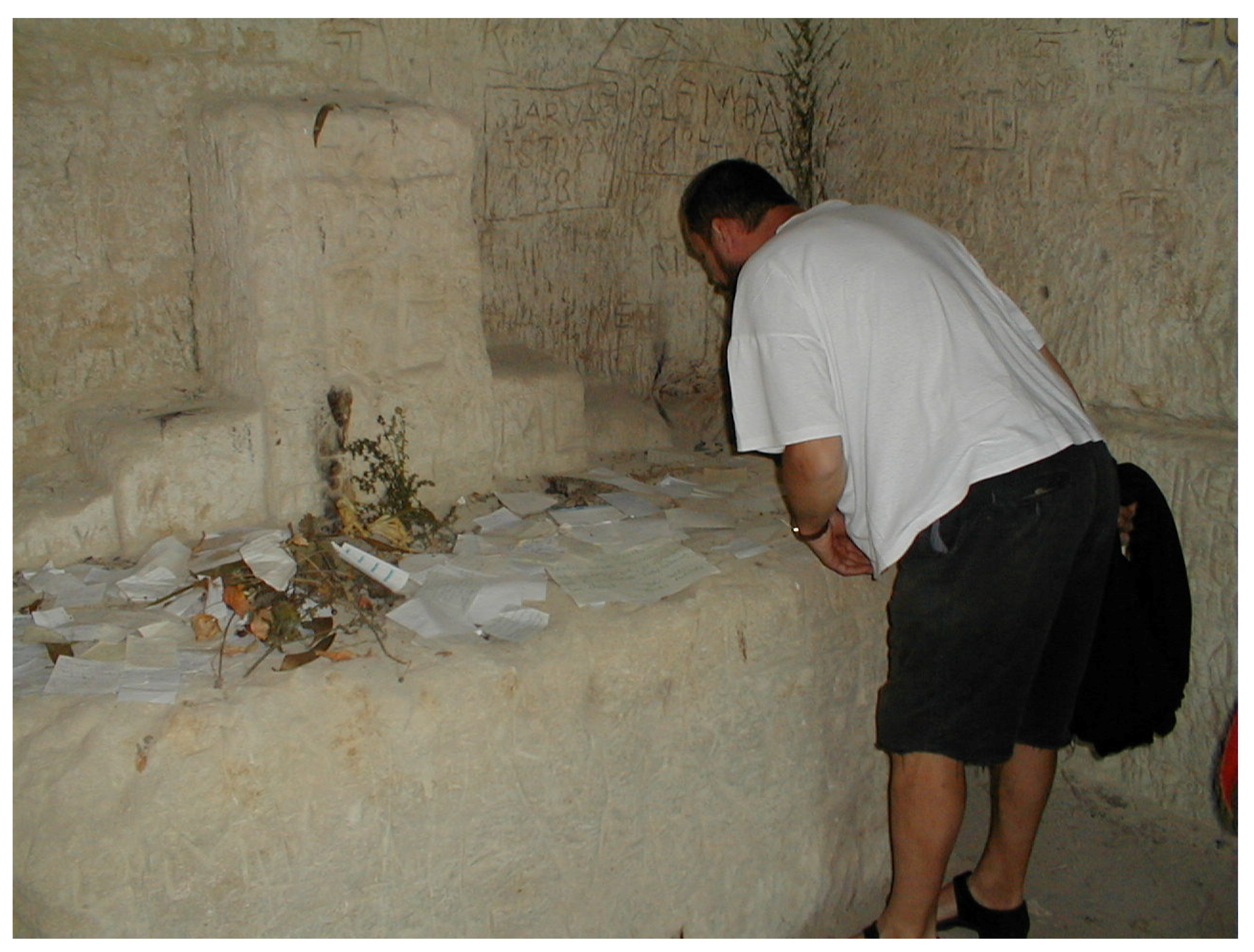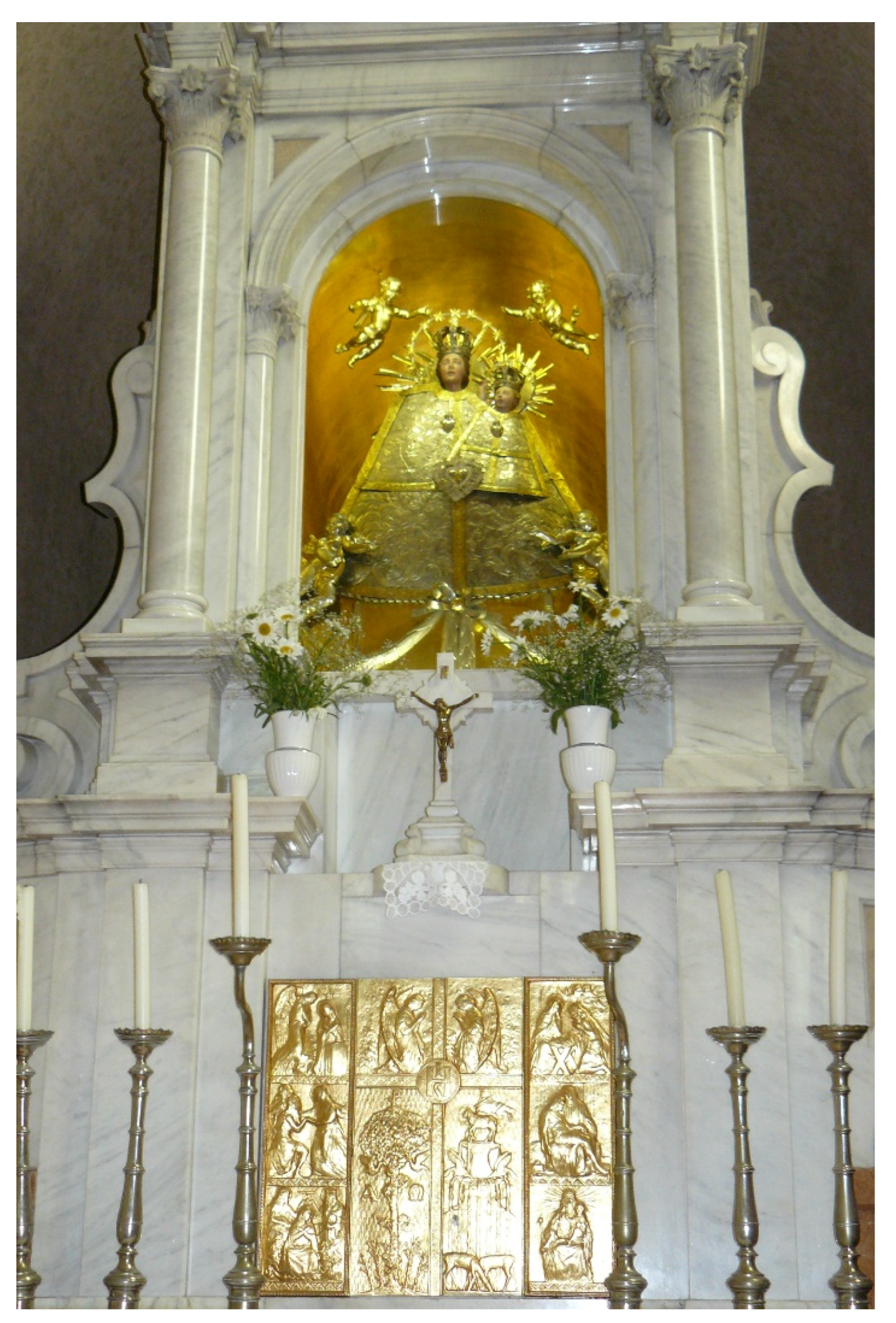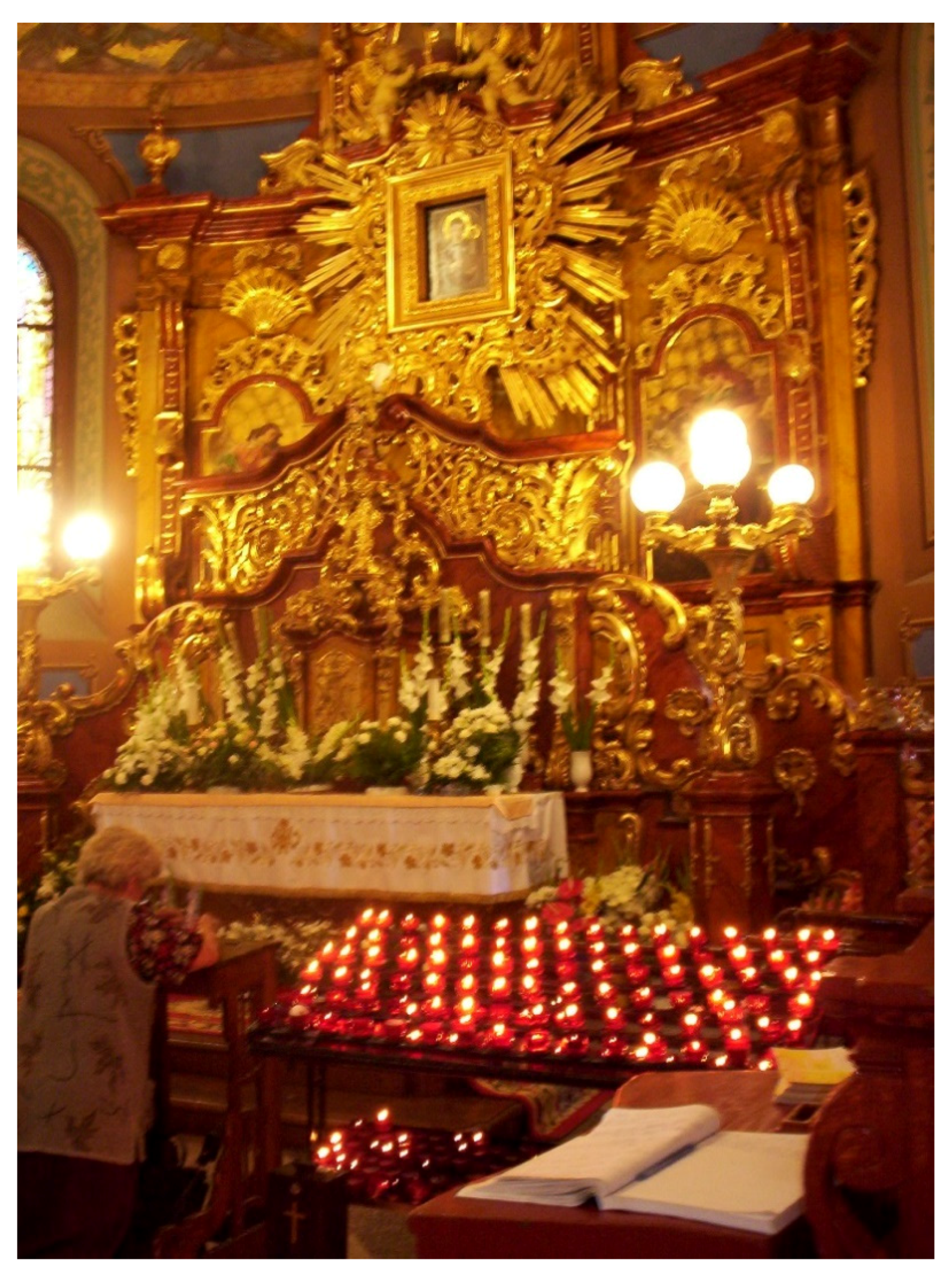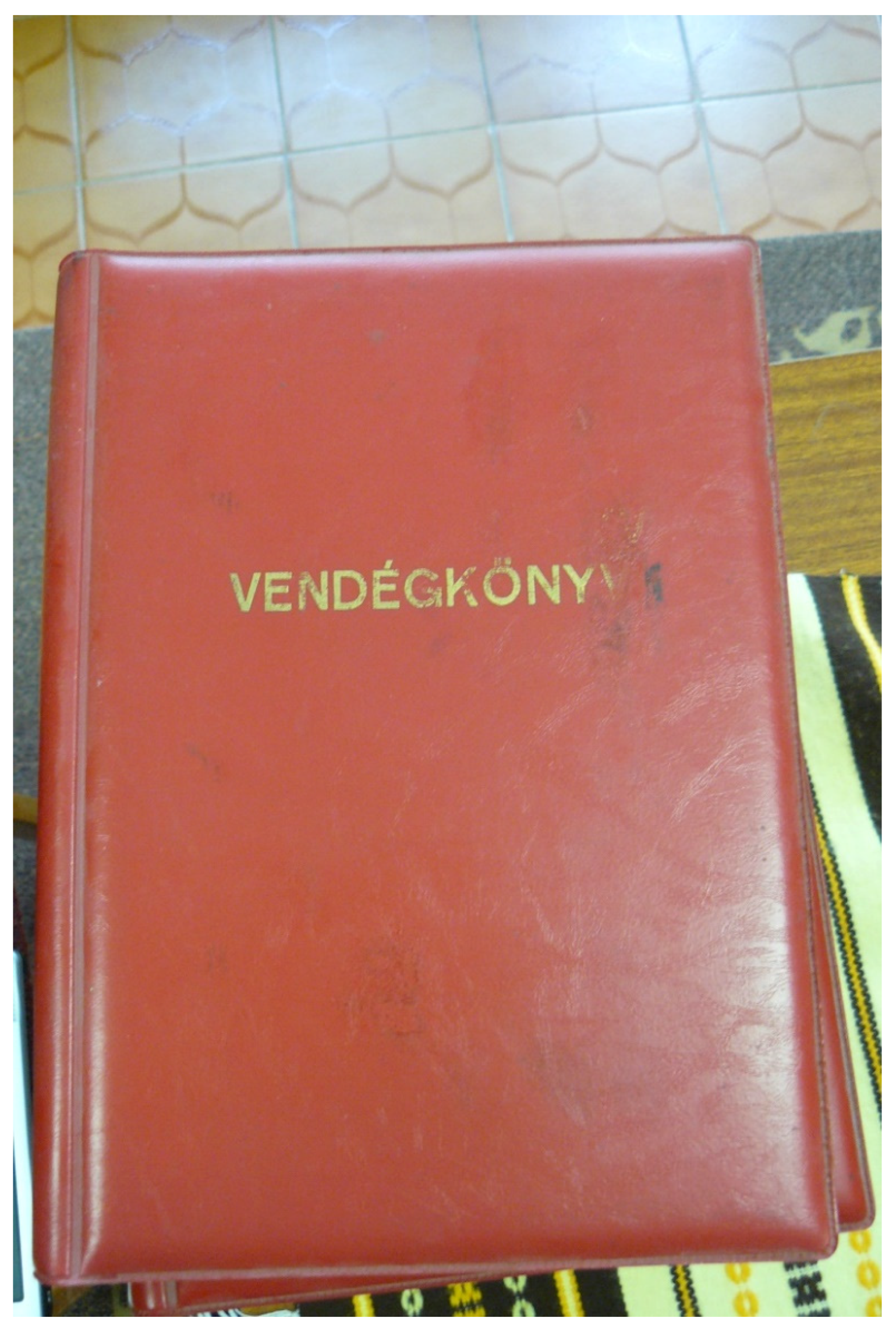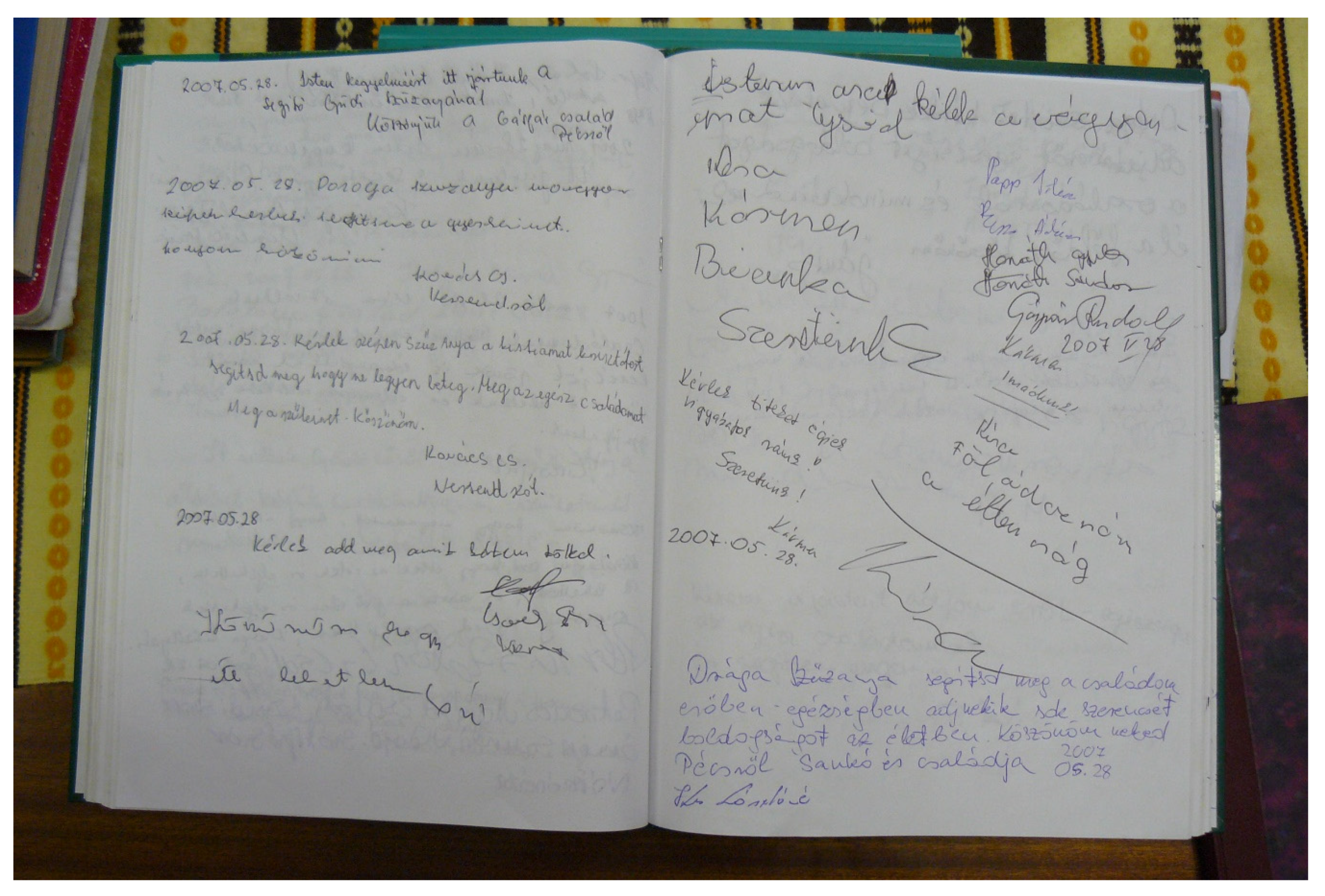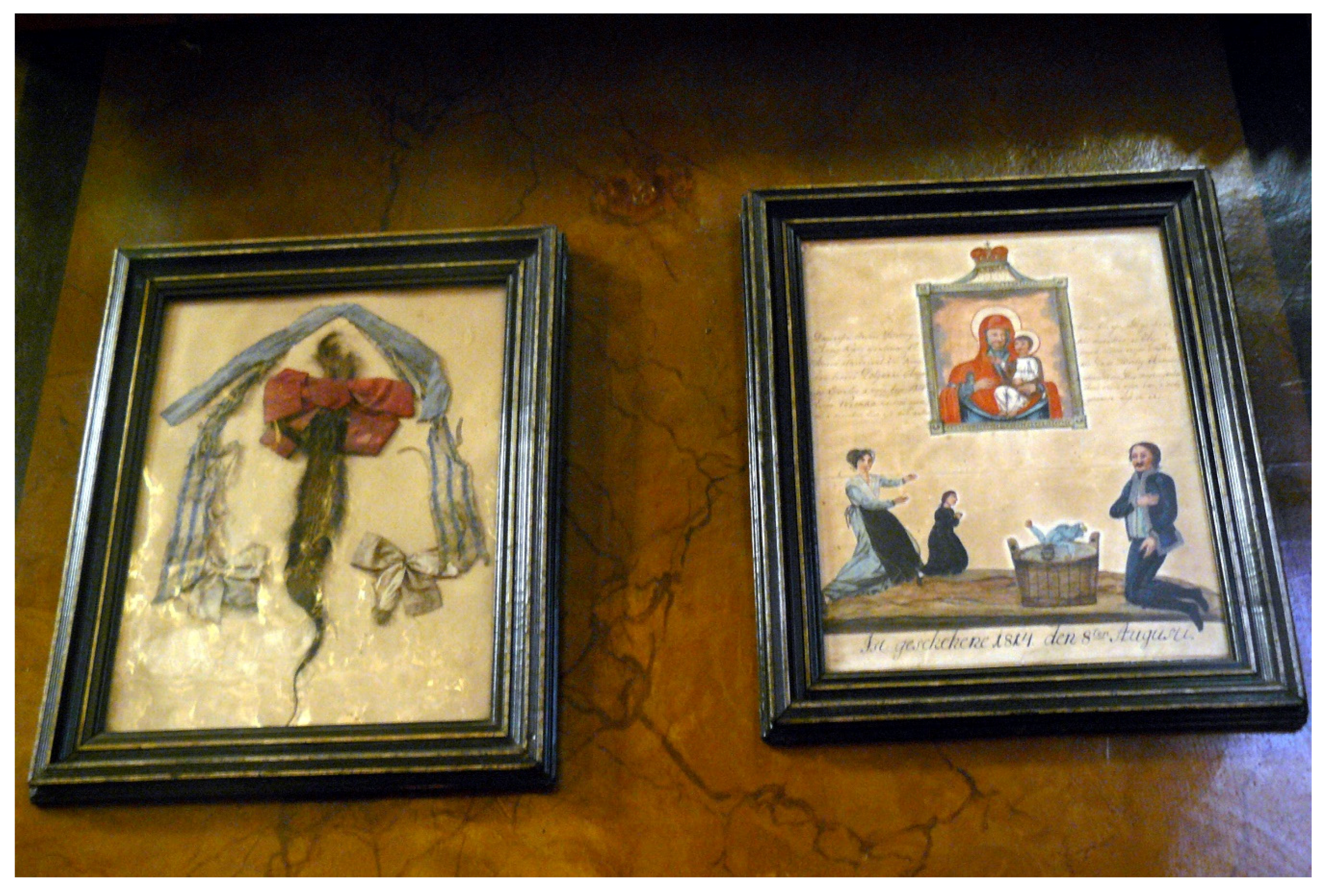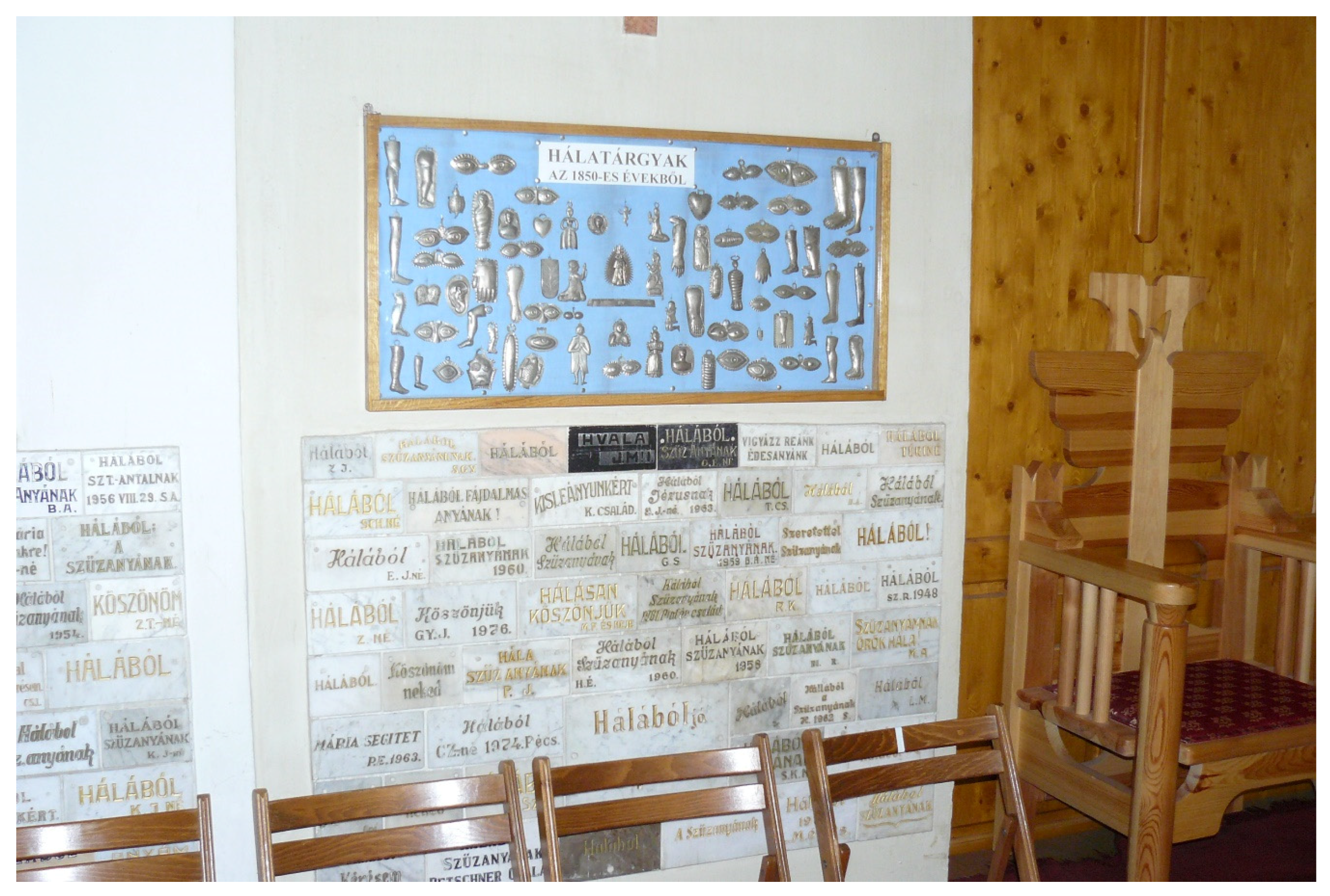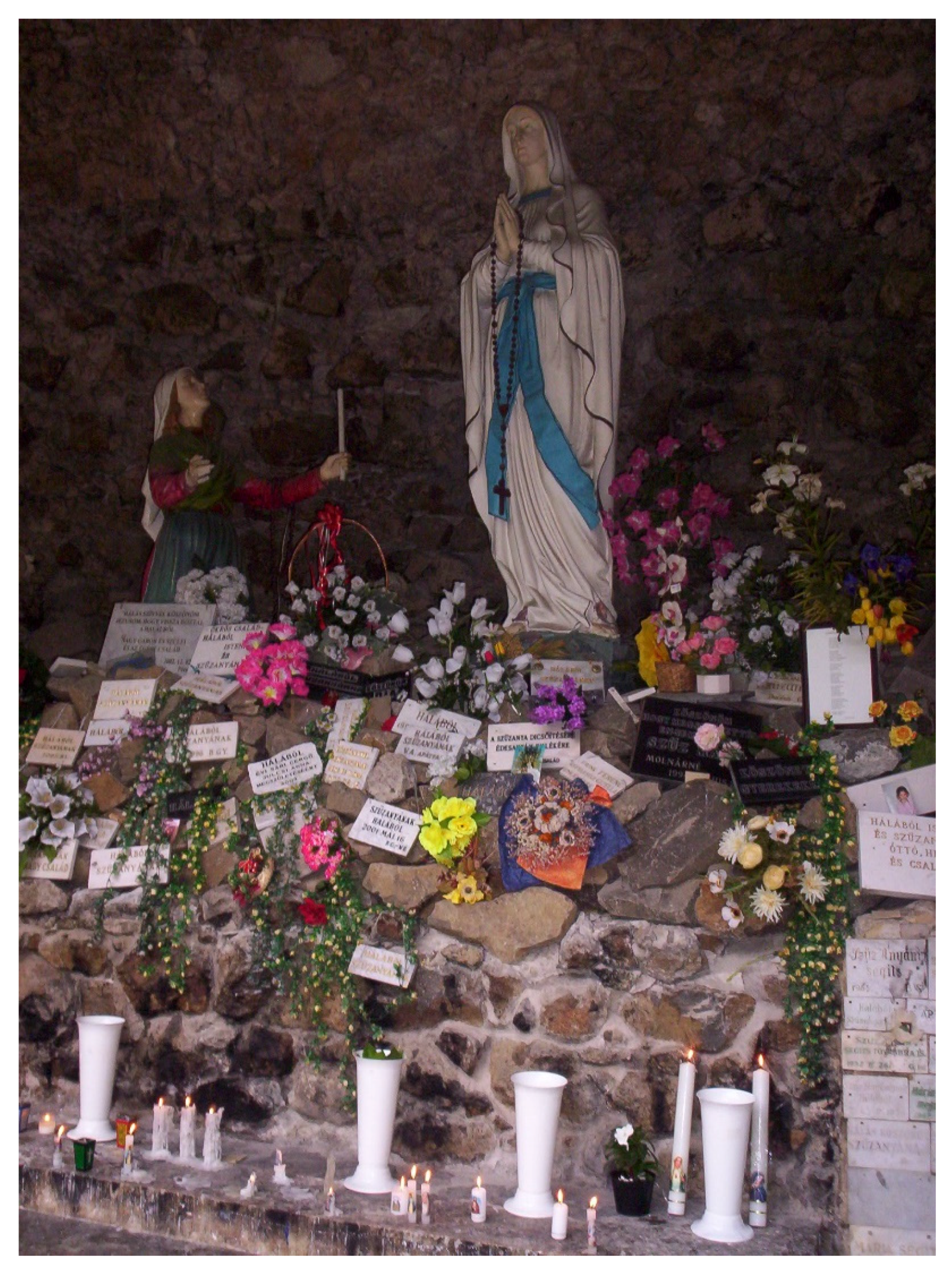1. Introduction: A New Phenomenon in the Practice of Devotion
In 1950, the renowned German ethnologist, Rudolf Kriss, published an article on the cult that was growing around the Capuchin brother Konrad von Parzham of Altötting, who had been canonised in 1934 (
Kriss 1950). In his study, Kriss wrote about the increasingly intensive veneration of the saint and drew attention to the appearance of a form of devotion that differed from the traditional. It had become an increasingly frequent element of devotion that the faithful visiting the site wrote long letters to the saint, and in their supplications as part of the Mass, the members of the local religious community said prayers based on the contents of those letters. As the number of letters increased, the communal prayer was discontinued, but the written prayers were carefully preserved (
Kriss 1950). In the same year, on the other side of the world, in the Peruvian city of Cuzco, a similar ethnological report appeared on the subject of written prayers placed before the image of Christ in the city’s cathedral (
Morote Best 1950). Meanwhile, if we returned to Europe, to the chapel of a tiny village in western Hungary in the same year, we could have made similar observations. Pilgrims to this site were able to write their personal requests and prayers of gratitude in a Guestbook placed there for that purpose (
Frauhammer 2012). A few years later, Walter Heim, a Swiss researcher, found, in research carried out in 1961, that these were not cultural relics, appearing independently of each other. He had information on a similar practice found in 40 shrines and 5 parish churches of 16 countries in Europe and elsewhere (e.g., Peru, Ceylon). Further examples could be given, and, advancing both in space and time, we find a dynamic increase in similar devotional practices over the half a century under consideration here.
This study examines the genre precedents, behaviour patterns and religious practices that led to the emergence of this written form of devotion in the period concerned. Is it merely a new element that can be placed in the chain of traditional devotional practices related to the veneration of saints and visits to pilgrimage shrines? Or has it been influenced also by other factors and behaviour patterns far from the context of pilgrimage? The role of the church and its clergy also raises another question. As the keepers of shrines and parishes, what was their role in giving instruction regarding practices related to these cults? How, and to what extent, were they able to influence these processes?
2. The Research
To answer my questions, I carried out research at five shrines in Hungary. The first site was a small village, Máriakálnok, in western Hungary, a lesser-known shrine with a small catchment area (
Figure 1).
The faithful here wrote their personal prayers and requests in a thick book known as the
Emlékkönyv (Remembrance Book). The parish priest of the village at the time placed it there in 1947, and entries were regularly made until 1952. During this period, 3190 entries were written on 324 pages. There is no information on whether the parish priest was guided by some kind of model in placing the book there, or whether it was his own idea. It was probably because of a few inappropriate entries that he removed it at the end of the five years. This stormy historical period, and the related prayers, lend special interest to the entries. They reflect the difficulties of reconstruction after the Second World War, the relocation of the Germans who had once lived there, and the crises of the newcomers who were settled there. The second research site is located in present-day Slovakia, the Hungarian-inhabited village of Egyházasbást-Vecseklő (Nová Bašta-Večelkov) (
Figure 2) (Up to the end of the First World War, the settlement was part of Hungary, but, under the Trianon Peace Treaty of 4 June 1920, it became part of Slovakia.).
This is a little-known shrine, located in a forest near the village. According to oral tradition, its origin is linked to a miraculous apparition of the Virgin Mary and to the nearby spring with a tiny chapel that was built here (big enough for only an altar and one chair); then in 2012 a new, larger chapel was built. From the 1970s, the woman who cared for the shrine at the time placed small notebooks here to redirect the practice of pilgrims to the site who used to write or scratch their requests and words of gratitude on the walls of the chapel. Since the church had not provided a “guardian” for the shrine, zealous local women kept it tidy. They have always ensured that new exercise books are placed when needed. During my research in 2012, I also observed that the full books were given a new life. They were placed beside prayer books, booklets for pilgrims and rosaries, so that visitors to the place for private devotions also leafed through them, drawing prayer texts from them. Mátraverebély-Szentkút, one of the most famous places of pilgrimage in Hungary, was my third research site. Here, the practice arose spontaneously, under the guidance of the clergy. From the 1990s, people began to leave prayer request slips on the altar of a former hermit’s cave near the pilgrimage church (
Figure 3).
Those who had no paper often wrote on postcards, paper serviettes, pieces torn from diaries, cheques or any other scrap of paper they could find to write their prayer. Each year, when cleaning up in preparation for a major feast day, the paper slips that increased in number from year to year were collected and burnt. This did not hinder pilgrims’ zeal and the practice continued. For over ten years now, pilgrims have been able to write in thick books marked Vendégkönyv (Guestbook) placed within the church, close to the statue that is the object of the cult.
Finally, I chose the shrines at Máriagyűd and Máriapócs as research sites (
Figure 4 and
Figure 5). Together with Mátraverebély-Szentkút, these are the best-known places of pilgrimage in Hungary. Guestbooks have been kept in Máriagyűd since 1970. While it took 12 years for the first large book with around 200 pages to fill up with prayers, by the end of the period examined, new books had to be made available every year. At first, the names of visitors and donations were recorded in the books, but such data were soon replaced by prayers. The situation is similar at the famous Greek Catholic shrine of Máriapócs, where such books began to be kept in 1900, very early by international comparison. For a long while, entries were made only by persons invited to do so, and the books were only occasionally placed out in the church. This practice has changed since 2001; anyone can write in the book placed on a special stand near the statue.
The number of books and prayer slips increased from year to year in all these places over the period examined, and this trend continued. The names used vary:
Emlékkönyv (Remembrance Book), Látogatási könyv (Visitors’ Book), Vendégkönyv (Guestbook). Whatever the name given to the books, they serve not only to record a visit to the shrine and the date of the visit, but have also become fora for contact with the Virgin Mother, Jesus or other saints.
My precious Virgin Mother!
I thank you for opening and smoothing my path so far. Thank you for opening my eyes and guiding me to the right path. I ask you to give me strength and health to continue to serve the health of others and protect the environment. I ask you to help my children too and guide them, give them happiness and family peace. Give my daughter the strength and determination to recover. Watch over my grandchild, my husband, my mother, protect them from self-destruction. I ask you to help me that I continue to have only love left in my heart and be able to cooperate with others too. I love you and your son Jesus. Thank you for everything.
(Visitors’ Book of Máriakálnok)
The example cited shows how a distinctive prayer practice has arisen in the books, notebooks and prayer slips in the form of requests and words of gratitude addressed to the Virgin Mother, personal sincere prayers, individual thoughts and confessions. The way they are written has not been formalised either in content, form or style, thereby affording many people the opportunity to enter into contact with various heavenly beings. In this way, a distinctive
sacral communication (
Lovász 2002) has been achieved through them, in written form, in a public, sacred space of a communal nature.
3. Questions of Definition
On the basis of elements of their function, structure and content, the prayer slips and guestbooks in the shrines presented here can be defined by the term
written devotion. The creation of this category can be linked to the authors of the first studies examining sources of a similar nature, Walter Heim (
Heim 1961) and Rudolf Kriss (
Kriss 1950). They included in this category also the texts of votive tablets, inscriptions and marble tablets on the walls of churches and chapels. Many common features justify the inclusion here of the guestbooks placed in churches and places of pilgrimage. What are these common features? Each of these possibilities creates a forum where visitors can express themselves in writing in a sacred place. The other common feature of these sources lies in the way they come into being and their function. Each manifestation bears witness to the religious devotion of the writer to the sacred, their gratitude, and its public expression. These two things are thus the lowest common denominator of these various text types that can be classified under the genre of written devotion (
Kromer 1996, p. 21). If we wish to place the sources of these texts in a wider context, we must mention the votive customs to which they are linked by the act of making internal, religious devotion public. Kriss-Rettenbeck used the concept of
promulgation borrowed from legal terminology to describe this act of making public (
Kriss-Rettenbeck 1958, p. 98). In this sense, the act of leaving written prayers at shrines is a visible manifestation of the devotee’s reliance on the sacred and their desire to take refuge in a sacred space. It is also a written demonstration of gratitude and praise for the patron of the shrine and their miraculous intercession. It is also a manifestation in writing of gratitude and praise for the patron of the shrine and their miraculous intervention. This act of making public, and the expression of faith on which our definition is based, is characteristic of all devotional manifestations of faith. However, many researchers have pointed out that in the case of entries in shrine guestbooks, considerations of a profane nature pointing beyond religious faith can also be observed. For example, people visiting the shrine as tourists have also written entries in these books as a way of leaving a memory and recording their thoughts. The individual’s existential need also appears in this act: the desire to leave a sign, trace, memory. Other entries suggest that some people used this opportunity in the manner of a diary, and on several returns recorded their state of mind at the particular time in the books placed there. I myself found similar examples in Csíksomlyó (Şumuleu, Romania) the largest shrine of ethnic Hungarians in Transylvania. It is as though they served as a substitute for a missing conversation partner. However, this kind of use shifts the phenomenon away from devotional traditions (
Ponisch 2001, pp. 201–12). Related to this use as a diary is a therapeutic aspect that also appears in a number of analyses. Writing down problems is a step towards their solution, it strengthens the feeling that the individual is not alone, and offers the reassurance that the possibility of divine aid exists even if all other explanatory systems fail (
Frida 2005, p. 198).
Dear good Virgin Mother!
I am very grateful that I can be here before you. I have had such a beautiful experience here it has made my whole soul as light as a feather. I have calmed down and returned with very great pleasure.
(Visitors’Book of Máriapócs)
All these considerations indicate that this 20th-century manifestation of the phenomenon defined here as written devotion also has features differing from its traditional forms. Compared to the traditional written devotional forms, we encounter here a far more spontaneous phenomenon where the forms of expression are treated much more freely. This creates the possibility for profane elements and motivations to appear beside the sacred, to mingle with each other, and become blurred. This kind of profanisation could also be observed in the subject matter of the texts; the classical votive themes (sickness, natural catastrophes, wars) were increasingly pushed into the background and, parallel with this, increasing space was devoted to the whole spectrum of everyday life (love, study, workplace problems, family problems, personal conflicts). It is at these points that the difference between church guestbooks and traditional written devotional sources can be seen most clearly.
The circumstances that led to the procurement and placing of such a book can also provide important information for a more precise definition of the books examined. In many cases, the different name given to these books is an unequivocal reference to this context. In Hungary they are called
Vendégkönyv (Guestbook),
Emlékkönyv (Remembrance Book). In Germany and Austria, the names are
Fürbittenbuch,
Anliegenbuch,
Wallfahrerbuch,
Pilgerbuch. In England too, they are also known as
Intercessions Books. These local names often indicate the purpose for which they were originally placed there (
Eberhardt and Ponisch 2000, p. 12). Concrete information and guidelines placed in them can also indicate the purpose of these books, as is the case in Máriakálnok:
In difficult times and with grave anxiety we open this book of remembrance to the glory of God, in veneration of the Blessed Virgin Mother and as a remembrance for later ages.
For years there was a similar book placed in a church near where I live. The following words could be read on a card placed beside the book:
Write down in this book your individual supplications and expressions of gratitude and the priest will include them in prayers during mass.
(Visitors’ Book of Máriakálnok)
Here, through these instructions, the priest or the community encouraged the faithful to write. Here, we may also be reminded of the decisions on liturgy of the Second Vatican Council that attempt to revive the practice of common prayer. The purpose of the guidance set out in Article 53 of Sacrosanctum Concilium was to involve the faithful more fully in the liturgy and to create a certain connection between church thinking and the everyday problems of the lay faithful.
We also know of pilgrimage and parish churches (for example: in Egyházasbást-Vecseklő/Nová Bašta-Večelkov, Mariazell, Eszék/Osijek, Croatia) where a notebook and pen were put out to protect the walls of the chapel from pilgrims who wished to write their prayers on the wall (
Lingens 1994, pp. 208–13;
Kraack et al. 2001, pp. 21–22;
Ponisch 1996, pp. 261–72;
Žmegač 1994, pp. 67–76;
Frauhammer 2010,
2012). This, too, was a possible way in which the church could channel the practice and motivate the faithful to pray in writing. However, it was not only the church or the parish priest who could motivate the faithful to write down prayers; often it could be the example of another person. At Mátraverebély-Szentkút small prayer slips appeared entirely spontaneously in the early 1990s on the altar of what was once a hermit’s cave near the shrine. The Franciscans who cared for the shrine did not remove them and so, in time, more and more paper slips appeared. Tristan Gray Hulse observed the same process in the St. Trillo chapel in Llandrillo-yn-Rhos, Wales. In 1992 the parish priest there found a paper slip in the chapel. He was so moved by what he read on it that he left it there. After a few weeks, new slips appeared, then more, and this continued without the parish priest encouraging anyone to act in this way (
Hulse 1995, p. 33). It therefore seems likely that, even unconsciously, people themselves could also have activated and encouraged each other. What we can see here is quite clearly the spontaneous emergence and spread of the custom. It also shows that even without the conscious guidance of the church, following the traditional behaviour patterns of the veneration of the saints, and pilgrimage practice, the faithful found the forms of expression that helped them to express their everyday problems and needs.
5. Universal Anthropological Character
Recording individual prayers in writing and making them public in a sacred place is not restricted exclusively to Catholic Christianity. Communication with the sacred in written form is a basic demand and desire of mankind. A similar practice is known among Jews, Orthodox Christians, Coptic Christians, even among Muslims and Japanese Shintoists in given periods. Hand-written prayer slips were known as
kvitli among people of the Jewish faith. The term means: little slip, “request slip”. Originally, people turned to miracle-working rabbis for advice, and pilgrims wrote down the reasons for their visit briefly on such slips of paper that were forwarded to the rabbi by his “secretary” before he received the visitors. Often money was expected for this mediation, known as a redemption payment, and the sum was later distributed among the poor. In some cases, the rabbi would write his answer on this slip. A hand-written or printed slip from the rabbi could also be called a
kvitli. With some modification, this form of sacred communication continued in the resting place of miracle-working rabbis. By the final decades of the 20th century, this practice became characteristic among the different trends of Jewry, as well as among non-Jews visiting the graves of
tsadiks (just men, generally deceased rebbes, orthodox rabbis, in some cases martyrs or their deceased relatives), and persons of other religions. Two variants spread in this connection. In the first case, slips containing requests were placed on the graves of just men by people visiting them. It was held that they had a place in the world to come and so could act as intermediaries, or their merits could serve as grounds for intercession. The other practice is the placing of slips containing requests between the stone blocks of the Wailing Wall. These can be addressed directly to the Everlasting (
Gleszer 2005, p. 118). This practice spread both among Israelis and persons living in the Diaspora who were making a pilgrimage to the Wailing Wall. Indeed, in the 1990s such requests could be sent by fax and an organisation undertook to take them to the Wall (
Kromer 1996, pp. 9–10).
In the period examined, parallels can also be found among the religious practices of the Japanese shintoists. The faithful paint or write their requests on small wooden tablets (
ema) and hang them on the wall set up for this purpose. Earlier, in the Middle Ages it was customary for people to offer horses to the shrines when they asked the divinity, the
kami for help in a big matter. In the case of smaller requests, they took the portrayal of a horse on a wooden tablet to the shrine; this became the origin of the 20th-century custom of placing on the wall set up for the purpose images drawn on small wooden tablets (there are no restrictions on what these images can portray). If a wish is fulfilled, another
ema is placed on the wall as a sign of gratitude. In their subjects these tablets also covered the whole spectrum of everyday life, just like the church guestbooks we examined (
Schmied 1997, pp. 99–100).
Prayer tablets and hand-written prayers also appear among Coptic Christians, and even appear in Muslim practice. In Turkey, it is a known practice that those suffering from a lack of something (most often the longing for a child and in cases of sickness), visit a renowned place of remembrance (a high rock, mountain, the grave of a famous religious leader), and together with the wish they leave a knotted scarf or ribbon. Nothing is written on this; the scarf is a symbolical representation of the request or prayer. Among the orthodox, the names of all the living and dead relatives, and friends for whom the writer would like the priest to pray in later ceremonies, are written on printed forms or blank sheets known as
zapiski (
Köllner et al. 2009, p. 18).
The practice of writing prayers arising in the course of the last decades of the 20th century not only among the cult of transcendent beings canonised by the different denominations. In the 1980s and 1990s a form of pilgrimage arose around the graves or monuments of stars from popular culture or public figures. Their places of remembrance became sacred places charged with performative power where the visitor could join in a more-or-less independent cult not attached to any further interpreting system—the cult of a star who had become an icon. Here, they could receive spiritual inspirations that could become sources of metaphysical experiences pointing beyond everyday life. Many people began to visit these places in the hope of such experiences, turning to the icon in whom they had invested special power (
Margry 2010, pp. 138–39). In this way, the deaths of Jim Morrison, Steve Prefontaine, and Princess Diana—and also their memorial sites—became cult places where transformed elements of the offering and devotional customs of traditional places of pilgrimage also appeared (flowers, candles, leaving commemorative and gift objects, special rites). Among these, in all cases, were hand-written supplications to the star, addressed as a saint, or requesting their intercession (
Bowman 2001;
Gennet and Rowbottom 2009;
Wojcik 2008;
Margry 2010).
All these examples illustrate the universal anthropological culture of written devotions spanning religions and cultures. They show that there is a demand present in the culture, independent of religious allegiance, and even outside the field of reference of the given religion for written communication with the person regarded as a saint.
6. Conclusions: Continuity, Innovation, and the Role of the Church
While searching for precedents of a new type of written devotion custom that appeared in the world in the second half of the 20th century, it became clear that there is an overlap and transition among certain traditional forms of devotion. It can be said that at the levels of content, form and function, countless elements of the known traditional written forms of devotion could be identified in the guestbooks. They appear in the 20th-century modern manifestation of written devotion simultaneously (
Eberhardt and Ponisch 2000, p. 24). However, in many cases, it is not possible to follow which emerged from what, what replaced which, or what became a substitute for which. Indeed, the order varied from one shrine to another: inscriptions on church walls replaced votive images; the book replaced inscriptions. Elsewhere, the texts of votive images became separate forms and lived on as prayer slips and letters, and then as a book. Elsewhere again, the gratitude tablet and/or a book replaced the votive graffiti, while in still other places, letters written to saints replaced inscriptions on the walls. My investigations in Máriapócs found that supplications replaced the records of miracles. Further, in a number of places, it was the intention that the books should serve a similar purpose to that of guestbooks in museums. In some places, such as Máriakálnok, as examined in the study, books intended for prayers of the faithful appeared without any precedent. In Mátraverebély-Szentkút, another of the places studied, prayer slips began to accumulate spontaneously. How then should we evaluate this devotional practice that appeared in the second half of the 20th century, which draws on a variety of traditions but nevertheless also has new features?
The interactions with parallel phenomena can help us to better understand guestbooks in shrines. The evocation of traditional forms, their combination with specifically modern aspects, and “finally the intertwining of sacred and profane contents, elements and functions are all criteria that make the books a characteristically postmodern phenomenon, even if at first sight all this appears in a church context.” (
Eberhardt and Ponisch 2000, p. 24). We must, therefore, consider the combined effect of three factors: the centuries-old traditions and patterns of the devotional practice supplemented with numerous innovative elements, and all this went together with an often conscious church strategy. The new kind of pilgrimage practice presented here arose from all these heterogeneous elements. Even if it is not possible everywhere and always to show a continuous connection with traditional devotional forms, it can be said that the aspiration hidden behind them—that in reality gives rise to these writings—has existed continuously for centuries: to enter into connection in written form with God, a saint or the Virgin Mary, and to make a request or give thanks for the actions taken. Naturally, this always happens in accordance with the demands and world picture of the given age, consequently the traditional forms are always and continuously undergoing transformation with ever newer and innovative elements. The church always follows with attention this popular religious practice and uses it to maintain the connection between the faithful and the church as an institution. Taking all this into account, it can be said that this is an invented tradition in the Hobsbawmian sense. We can find in it—although in a form adapted to the circumstances of our time—the ritual and symbolical elements, rules and motivations of the practice of written devotion that, through repetition, automatically create continuity with the past. Hobsbawm indicates that “these continuities of course are largely factitious, in reality they are responses to novel situations that take the form of reference to old situations.” (
Hobsbawm and Ranger 1989, p. 2). Two tendencies come together in this: the constant change and renewal of the modern world; and the unchanging nature of certain behavioural norms of social life (
Hobsbawm and Ranger 1989, p. 2). The guestbooks in shrines are good examples of how these two seemingly opposite processes are able to keep the practice of written devotion alive.
